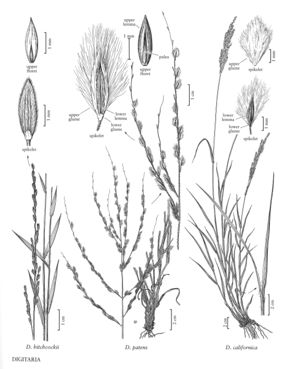Digitaria hitchcockii
Plants perennial; rhizomatous, rhizomes short, giving the plants hard, knotty, much-branched bases. Culms 20-55 cm, erect, sometimes geniculate, not rooting at the lower nodes. Basal sheaths tomentose; culm sheaths glabrous or variously pubescent (puberulent, ciliate, or sparsely hirsute); ligules (0.1) 0.5-1 (1.5) mm, ciliate; blades 2-5.5 cm long, 2-3 mm wide. Panicles with 3-6 spikelike primary branches on 6-10 (15) cm rachises; primary branches 1-6 cm, not or only narrowly winged, bearing spikelets in unequally pedicellate pairs, pedicels not adnate to the branch axes; shorter pedicels 1.5-2 mm; longer pedicels 3-4 mm. Spikelets homomorphic, 2.5-3.1 mm (including pubescence), 2.4-3 mm (excluding pubescence). Lower glumes 0.3-1 mm, veinless; upper glumes 2.1-3 mm (including pubescence), as long as or exceeding the upper florets by no more than 0.5 mm, 3-veined, densely appressed-pubescent, hairs 0.5-1 mm, white to purple, tapering or parallel-sided, not spreading at maturity; lower lemmas 2.3-3.1 mm (including pubescence), as long as or exceeding the upper lemmas by up to 0.5 mm, 5-veined, veins equally spaced, intercostal regions densely appressed-pubescent, hairs 0.5-1 mm, white to purple, tapering or parallel-sided, not spreading at maturity; upper lemmas 2.2-2.5 mm, brown when immature, dark-brown at maturity. Caryopses 2.1-3.4 mm. 2n = 36.
Distribution
Virgin Islands, Tex.
Discussion
Digitaria hitchcockii is an uncommon species of open, dry, gravelly slopes in southwestern Texas and northern Mexico.
Selected References
None.
Lower Taxa
"decumbent" is not a number.
